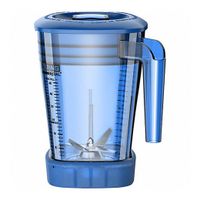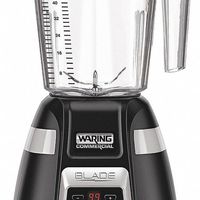Call +(254) 703 030 000 / 751 483 999 / 721 704 777
- Home
- Furnishings Appliances Hospitality
- Appliances
- Food Processors Mixers Blenders
- Carafe Blenders Accessories
.....Read More
Frequently Asked Questions
What are the best carafe blenders for making sauces and soups?
1. **Vitamix 5200**: Known for its powerful motor and durable construction, the Vitamix 5200 is excellent for making smooth sauces and soups. Its variable speed control allows for precise texture adjustments, and the large 64-ounce container is perfect for family-sized batches.
2. **Blendtec Total Classic Original Blender**: With its pre-programmed cycles and strong motor, the Blendtec Total Classic is ideal for creating creamy soups and sauces. The WildSide+ jar design enhances blending efficiency, and the blunt blades ensure safety and longevity.
3. **Ninja Foodi Cold & Hot Blender**: This versatile blender can handle both cold and hot ingredients, making it perfect for soups and sauces. It features a built-in heating element for cooking soups directly in the blender, and its Auto-iQ technology offers intelligent blending programs.
4. **Breville Super Q Blender**: The Breville Super Q offers a powerful motor and noise suppression technology, making it a quiet yet efficient option for blending sauces and soups. It includes multiple speed settings and a dedicated soup function for optimal results.
5. **KitchenAid K400 Blender**: With its sturdy design and powerful motor, the KitchenAid K400 is great for making smooth sauces and soups. It features a unique asymmetric blade and Intelli-Speed motor control to maintain optimal speed for consistent blending.
6. **Oster Pro 1200 Blender**: A budget-friendly option, the Oster Pro 1200 offers a powerful motor and dual-direction blade technology for efficient blending. It includes pre-programmed settings for soups and sauces, making it a versatile choice for home cooks.
7. **Hamilton Beach Professional Quiet Shield Blender**: This blender combines power and quiet operation, making it suitable for sauces and soups. It features a sound enclosure to reduce noise and a powerful motor for smooth blending.
How do I clean and maintain my carafe blender?
1. **Unplug and Disassemble**: Ensure the blender is unplugged. Remove the carafe, lid, and blade assembly.
2. **Rinse Immediately**: Rinse the carafe and lid with warm water immediately after use to prevent food from drying and sticking.
3. **Soak and Scrub**: Fill the carafe with warm water and a few drops of dish soap. Let it soak for a few minutes. Use a soft sponge or brush to scrub the interior, focusing on the corners and blade area.
4. **Clean the Blade**: Carefully remove the blade assembly if detachable. Use a brush to clean around the blades. Be cautious to avoid cuts.
5. **Lid and Gasket**: Wash the lid and any removable gaskets with warm soapy water. Use a brush to clean crevices.
6. **Rinse Thoroughly**: Rinse all parts with clean water to remove soap residue.
7. **Dry Completely**: Allow all parts to air dry or use a clean towel. Ensure the blade assembly is completely dry to prevent rust.
8. **Reassemble**: Once dry, reassemble the blender.
9. **Exterior Cleaning**: Wipe the blender base with a damp cloth. Avoid submerging it in water. Use a toothbrush to clean buttons and crevices.
10. **Deep Cleaning**: For stubborn stains or odors, blend a mixture of equal parts water and white vinegar or baking soda. Rinse thoroughly afterward.
11. **Regular Maintenance**: Regularly check for wear and tear, especially on the blade and gasket. Replace if necessary.
12. **Storage**: Store the blender with the lid off to prevent odors.
13. **Avoid Dishwasher**: Unless specified by the manufacturer, avoid using a dishwasher as it may damage parts.
14. **Safety**: Always handle blades with care and follow manufacturer instructions for cleaning and maintenance.
What accessories are available for carafe blenders?
Accessories for carafe blenders include:
1. **Tamper**: A tool used to push ingredients down towards the blades for smoother blending, especially useful for thick mixtures.
2. **Extra Blades**: Replacement or specialized blades for different blending needs, such as ice crushing or chopping.
3. **Additional Carafes**: Extra blending jars, often in different sizes or materials, for convenience and versatility.
4. **Lids and Caps**: Replacement or additional lids, sometimes with spouts or measuring caps for easy pouring and ingredient measurement.
5. **Travel Cups**: Personal-sized cups with lids for blending and taking smoothies on the go.
6. **Sealing Rings/Gaskets**: Replacement seals to ensure a tight fit and prevent leaks.
7. **Cleaning Brushes**: Special brushes designed to clean hard-to-reach areas of the blender and blades.
8. **Pour Spouts**: Attachments that make pouring easier and reduce spills.
9. **Storage Lids**: Lids that allow the carafe to be used for storage in the refrigerator.
10. **Sound Enclosures**: Covers that reduce noise during blending, useful for high-power blenders.
11. **Recipe Books**: Guides or books with recipes specifically designed for use with the blender.
12. **Motor Base Covers**: Protective covers for the motor base to keep it clean and dust-free.
13. **Spatulas**: Specially designed spatulas to scrape down the sides of the carafe.
14. **Measuring Cups**: Cups that fit into the lid for easy ingredient measurement.
15. **Ice Cube Trays**: Trays designed to make ice cubes that fit perfectly into the blender for efficient ice crushing.
16. **Vacuum Pumps**: Devices that remove air from the carafe to preserve freshness and prevent oxidation.
These accessories enhance the functionality, convenience, and maintenance of carafe blenders.
Can carafe blenders crush ice for cold beverages?
Yes, carafe blenders can crush ice for cold beverages, but their effectiveness depends on several factors. The power of the blender's motor is crucial; typically, a motor with at least 500 watts is recommended for crushing ice efficiently. Blenders with higher wattage can handle ice more effectively, reducing the risk of motor strain or damage.
The design and material of the blades also play a significant role. Blenders with strong, durable stainless steel blades are better suited for crushing ice. Some blenders have specially designed blades that create a vortex, pulling ice down for more efficient crushing.
The carafe material is another consideration. Glass carafes are generally more durable and less likely to scratch compared to plastic ones, which can become cloudy or scratched over time. However, high-quality, BPA-free plastic carafes are also available and can be effective.
Blender settings and features can enhance ice-crushing capabilities. Many blenders come with pre-programmed settings or pulse functions specifically for ice crushing, allowing for better control and consistency.
It's important to use the right technique when crushing ice. Adding a small amount of liquid can help the process, and it's advisable to start with smaller amounts of ice to avoid overloading the blender.
In summary, while many carafe blenders can crush ice, the best results are achieved with a powerful motor, durable blades, and appropriate settings. Always refer to the manufacturer's guidelines to ensure your blender is suitable for ice crushing to avoid damage and ensure safety.
How do I replace missing or broken parts of my carafe blender?
1. **Identify the Parts Needed**: Determine which parts are missing or broken. Common parts include the lid, blade assembly, jar, base, or gasket.
2. **Consult the Manual**: Refer to the blender’s user manual for part numbers and specifications. This ensures compatibility with your specific model.
3. **Contact the Manufacturer**: Reach out to the blender’s manufacturer for replacement parts. They often provide genuine parts and may offer guidance on installation.
4. **Visit Authorized Dealers**: Check with authorized dealers or service centers for availability of parts. They can also assist with installation if needed.
5. **Online Retailers**: Search online marketplaces like Amazon, eBay, or specialized appliance parts websites. Ensure the parts are compatible with your blender model.
6. **Local Appliance Stores**: Visit local appliance or kitchenware stores. They may stock common replacement parts or can order them for you.
7. **Second-Hand Options**: Consider purchasing used parts from thrift stores or online platforms. Ensure they are in good condition and compatible.
8. **DIY Repair**: If you are comfortable with DIY repairs, use online tutorials or videos for guidance on replacing parts. Ensure you have the necessary tools.
9. **Safety Precautions**: Always unplug the blender before attempting any repairs. Follow safety guidelines to avoid injury.
10. **Test the Blender**: After replacing the parts, test the blender to ensure it functions correctly. Check for leaks or unusual noises.
11. **Warranty Considerations**: If your blender is under warranty, check if the replacement is covered. Unauthorized repairs may void the warranty.
12. **Professional Repair Services**: If unsure, consider hiring a professional repair service to replace the parts. They have the expertise and tools to ensure proper installation.
What is the difference between a carafe blender and a personal blender?
A carafe blender, often referred to as a countertop or full-size blender, is designed for larger volume blending tasks. It typically features a sizable jar or pitcher, usually made of glass or durable plastic, with a capacity ranging from 48 to 72 ounces or more. This type of blender is equipped with a powerful motor, often between 500 to 1500 watts, making it suitable for a variety of tasks such as crushing ice, making smoothies, soups, sauces, and even grinding nuts or grains. Carafe blenders often come with multiple speed settings and pre-programmed functions, providing versatility for different blending needs. They are ideal for families or individuals who frequently prepare large batches of food or beverages.
In contrast, a personal blender is compact and designed for single-serving tasks. It usually features a smaller blending container, often doubling as a travel cup, with a capacity ranging from 12 to 24 ounces. Personal blenders are equipped with a less powerful motor, typically between 200 to 600 watts, which is sufficient for making smoothies, protein shakes, or small quantities of sauces and dressings. They are convenient for quick, on-the-go blending and are easy to clean and store due to their compact size. Personal blenders are ideal for individuals or those with limited kitchen space who prioritize convenience and portability over large-scale blending capabilities.
In summary, the main differences between a carafe blender and a personal blender lie in their size, capacity, motor power, and intended use. Carafe blenders are suited for larger, more versatile tasks, while personal blenders are designed for quick, single-serve applications.
How do I choose the right carafe blender for my needs?
1. **Purpose and Usage**: Determine what you'll primarily use the blender for—smoothies, soups, crushing ice, or nut butters. This will guide you in choosing the right power and features.
2. **Power**: For basic tasks like smoothies and soups, a blender with 300-600 watts is sufficient. For crushing ice or making nut butters, consider a blender with at least 1000 watts.
3. **Capacity**: Choose a carafe size based on your needs. A 32-ounce carafe is suitable for single servings, while a 64-ounce or larger is ideal for families or batch cooking.
4. **Material**: Carafes are typically made of glass or plastic. Glass is more durable and doesn’t retain odors, but it’s heavier. Plastic is lighter and less prone to breaking but may scratch or retain odors over time.
5. **Blades**: Look for stainless steel blades for durability and efficiency. Some blenders have removable blades for easier cleaning.
6. **Speed and Settings**: Multiple speed settings and pre-programmed functions offer versatility. Consider blenders with pulse functions for better control.
7. **Ease of Cleaning**: Opt for blenders with dishwasher-safe parts or self-cleaning functions to save time and effort.
8. **Noise Level**: High-power blenders can be noisy. If noise is a concern, look for models with noise-reduction features.
9. **Budget**: Set a budget. High-end blenders offer more features and durability but come at a higher price. Balance your needs with what you’re willing to spend.
10. **Brand and Warranty**: Choose reputable brands known for quality and customer service. A good warranty can provide peace of mind.
11. **Reviews and Recommendations**: Read customer reviews and expert recommendations to gauge performance and reliability.

